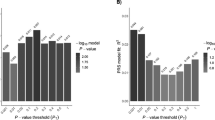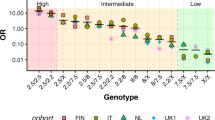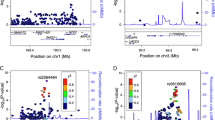Abstract
An interesting candidate gene region for coeliac disease (CD), a common multifactorial disease, is a segment on 2q33–37 harbouring the genes for the CD28, cytotoxic T-lymphocyte-associated antigen-4 (CTLA4), inducible costimulator (ICOS), and programmed death-1 (PD-1), all receptors that regulate lymphocyte activation. Several studies have suggested a role for this locus in immune-mediated diseases. To study further our previous finding of genetic linkage of this region to CD, we studied 25 polymorphic markers to identify the putative disease-associated polymorphism. Transmission/disequilibrium test in 106 Finnish families with CD indicated that only four polymorphisms, all located in the ICOS gene, showed evidence for genetic association. Strong linkage disequilibrium (LD), based on the analysis of 424 haplotypes, encompassed not only the associated ICOS markers but also many polymorphisms in the CTLA4 gene. Our results demonstrate that due to LD, it appears not easy to identify the genuine susceptibility factor in this region without larger multipopulation studies. Furthermore, the results did not support the evidence that polymorphisms in CTLA4 were the major susceptibility locus for CD.
This is a preview of subscription content, access via your institution
Access options
Subscribe to this journal
Receive 6 digital issues and online access to articles
$119.00 per year
only $19.83 per issue
Buy this article
- Purchase on Springer Link
- Instant access to full article PDF
Prices may be subject to local taxes which are calculated during checkout


Similar content being viewed by others
References
Kristiansen OP, Larsen ZM, Pociot F . CTLA-4 in autoimmune diseases—a general susceptibility gene to autoimmunity? Genes Immun 2000; 1: 170–184.
Carreno BM, Collins M . The B7 family of ligands and its receptors: new pathways for costimulation and inhibition of immune responses. Annu Rev Immunol 2002; 20: 29–53.
Nisticó L, Buzzetti R, Pritchard LE et al. The CTLA-4 gene region of chromosome 2q33 is linked to, and associated with, type 1 diabetes. Hum Mol Genet 1996; 5: 1075–1080.
Holopainen PM, Partanen JA . Technical note: linkage disequilibrium and disease-associated ctla4 gene polymorphisms. J Immunol 2001; 167: 2457–2458.
Kouki T, Sawai Y, Gardine C, Fisfalen M-E, Alegre M-L, DeGroot LJ . CTLA-4 gene polymorphism at position 49 in exon 1 reduces the inhibitory function of CTLA-4 and contributes to the pathogenesis of Graves' disease. J Immunol 2000; 165: 6606–6611.
Huang D, Giscombe R, Zhou Y, Pirskanen R, Lefvert AK . Dinucleotide repeat expansion in the CTLA-4 gene leads to T cell hyper-reactivity via the CD28 pathway in myasthenia gravis. J Neuroimmunol 2000; 105: 69–77.
Ligers A, Teleshova N, Masterman T, Huang WX, Hillert J . CTLA-4 gene expression is influenced by promoter and exon 1 polymorphisms. Genes Immun 2001; 2: 145–152.
Maurer M, Loserth S, Kolb-Maurer A et al. A polymorphism in the human cytotoxic T-lymphocyte antigen 4 (CTLA4) gene (exon 1 +49) alters T-cell activation. Immunogenetics 2002; 54: 1–8.
Wang XB, Zhao X, Giscombe R, Lefvert AK . A CTLA-4 gene polymorphism at position −318 in the promoter region affects the expression of protein. Genes Immun 2002; 3: 233–234.
Anjos S, Nguyen A, Ounissi-Benkalha H, Tessier MC, Polychronakos C . A common autoimmunity predisposing signal peptide variant of the cytotoxic T-lymphocyte antigen 4 results in inefficient glycosylation of the susceptibility allele. J Biol Chem 2002; 277: 46478–46486.
Marron MP, Zeidler A, Raffel LJ et al. Genetic and physical mapping of a type 1 diabetes susceptibility gene (IDDM12) to a 100-kb phagemid artificial chromosome clone containing D2S72–CTLA4–D2S105 on chromosome 2q33. Diabetes 2000; 49: 492–499.
Ihara K, Ahmed S, Nakao F et al. Association studies of CTLA-4, CD28, and ICOS gene polymorphisms with type 1 diabetes in the Japanese population. Immunogenetics 2001; 53: 447–454.
Haimila KE, Partanen JA, Holopainen PM . Genetic polymorphism of the human ICOS gene. Immunogenetics 2002; 53: 1028–1032.
Ueda H, Howson JM, Esposito L et al. Association of the T-cell regulatory gene CTLA4 with susceptibility to autoimmune disease. Nature 2003; 423: 506–511.
Maki M, Collin P . Coeliac disease. Lancet 1997; 349: 1755–1759.
Karell K, Louka AS, Moodie SJ et al. Hla types in celiac disease patients not carrying the DQA1*05-DQB1*02 (DQ2) heterodimer: results from the european genetics cluster on celiac disease. Hum Immunol 2003; 64: 469–477.
Bevan S, Popat S, Braegger CP et al. Contribution of the MHC region to the familial risk of coeliac disease. J Med Genet 1999; 36: 687–690.
Petronzelli F, Bonamico M, Ferrante P et al. Genetic contribution of the HLA region to the familial clustering of coeliac disease. Ann Hum Genet 1997; 61: 307–317.
Risch N . Assessing the role of HLA-linked and unlinked determinants of disease. Am J Hum Genet 1987; 40: 1–14.
Rotter JI, Landaw EM . Measuring the genetic contribution of a single locus to a multilocus disease. Clin Genet 1984; 26: 529–542.
Zhong F, McCombs CC, Olson JM et al. An autosomal screen for genes that predispose to celiac disease in the western counties of Ireland. Nat Genet 1996; 14: 329–333.
Greco L, Corazza G, Babron MC et al. Genome search in celiac disease. Am J Hum Genet 1998; 62: 669–675.
King AL, Yiannakou JY, Brett PM et al. A genome-wide family-based linkage study of coeliac disease. Ann Hum Genet 2000; 64: 479–490.
Naluai AT, Nilsson S, Gudjonsdottir AH et al. Genome-wide linkage analysis of Scandinavian affected sib-pairs supports presence of susceptibility loci for celiac disease on chromosomes 5 and 11. Eur J Hum Genet 2001; 9: 938–944.
Liu J, Juo SH, Holopainen P et al. Genomewide linkage analysis of celiac disease in Finnish families. Am J Hum Genet 2002; 70: 51–59.
Woolley N, Holopainen P, Ollikainen V et al. A new locus for coeliac disease mapped to chromosome 15 in a population isolate. Hum Genet 2002; 111: 40–45.
Popat S, Bevan S, Braegger CP et al. Genome screening of coeliac disease. J Med Genet 2002; 39: 328–331.
Neuhausen SL, Feolo M, Camp NJ, Farnham J, Book L, Zone JJ . Genome-wide linkage analysis for celiac disease in North American families. Am J Med Genet 2002; 111: 1–9.
Holopainen P, Arvas M, Sistonen P et al. CD28/CTLA4 gene region on chromosome 2q33 confers genetic susceptibility to celiac disease. A linkage and family-based association study. Tissue Antigens 1999; 53: 470–475.
Naluai AT, Nilsson S, Samuelsson L et al. The CTLA4/CD28 gene region on chromosome 2q33 confers susceptibility to celiac disease in a way possibly distinct from that of type 1 diabetes and other chronic inflammatory disorders. Tissue Antigens 2000; 56: 350–355.
Djilali-Saiah I, Schmitz J, Harfouch-Hammoud E, Mougenot J-F, Bach J-F, Caillat-Zucman S . CTLA-4 gene polymorphism is associated with predisposition to coeliac disease. Gut 1998; 43: 187–189.
Mora B, Bonamico M, Indovina P et al. CTLA-4 +49 A/G dimorphism in Italian patients with celiac disease. Hum Immunol 2003; 64: 297–301.
King AL, Moodie SJ, Fraser JS et al. CTLA-4/CD28 gene region is associated with genetic susceptibility to coeliac disease in UK families. J Med Genet 2002; 39: 51–54.
Clot F, Fulchignoni-Lataud MC, Renoux C et al. Linkage and association study of the CTLA-4 region in coeliac disease for Italian and Tunisian populations. Tissue Antigens 1999; 54: 527–530.
Ishida Y, Agata Y, Shibahara K, Honjo T . Induced expression of PD-1, a novel member of the immunoglobulin gene superfamily, upon programmed cell death. EMBO J 1992; 11: 3887–3895.
Nishimura H, Honjo T . PD-1: an inhibitory immunoreceptor involved in peripheral tolerance. Trends Immunol 2001; 22: 265–268.
Prokunina L, Castillejo-López C, Berg F et al. A regulatory polymorphism in PDCD1 is associated with susceptibility to systemic lupus erythematosus in humans. Nat Genet 2002; 32: 666–669.
Holopainen P, Torinsson Naluai A, Moodie S et al. Candidate gene region 2q33 in European families with coeliac disease. Tissue Antigens 2004; 63: 1–11.
Dong C, Juedes AE, Temann UA et al. ICOS co-stimulatory receptor is essential for T-cell activation and function. Nature 2001; 409: 97–101.
Tafuri A, Shahinian A, Bladt F et al. ICOS is essential for effective T-helper-cell responses. Nature 2001; 409: 105–109.
Yoshinaga SK, Whoriskey JS, Khare SD et al. T-cell co-stimulation through B7RP-1 and ICOS. Nature 1999; 402: 827–832.
McAdam AJ, Greenwald RJ, Levin MA et al. ICOS is critical for CD40-mediated antibody class switching. Nature 2001; 409: 102–105.
Sulkanen S, Halttunen T, Laurila K et al. Tissue transglutaminase autoantibody enzyme-linked immunosorbent assay in detecting celiac disease. Gastroenterology 1998; 115: 1322–1328.
Halttunen T, Maki M . Serum immunoglobulin A from patients with celiac disease inhibits human T84 intestinal crypt epithelial cell differentiation. Gastroenterology 1999; 116: 566–572.
Haaning Andersen AD, Lange M, Lillevang ST . Allelic variation of the inducible costimulator (ICOS) gene: detection of polymorphisms, analysis of the promoter region, and extended haplotype estimation. Tissue Antigens 2003; 61: 276–285.
Mustalahti K, Sulkanen S, Holopainen P et al. Coeliac disease among healthy members of multiple case coeliac disease families. Scand J Gastroenterol 2002; 37: 161–165.
Deichmann K, Heinzmann A, Bruggenolte E, Forster J, Kuehr J . An Mse I RFLP in the human CTLA4 promotor. Biochem Biophys Res Commun 1996; 225: 817–818.
Polymeropoulos MH, Xiao H, Rath DS, Merril CR . Dinucleotide repeat polymorphism at the human CTLA4 gene. Nucleic Acids Res 1991; 19: 4018.
Spielman RS, McGinnis RE, Ewens WJ . Transmission test for linkage disequilibrium: the insulin gene region and insulin-dependent diabetes mellitus (IDDM). Am J Hum Genet 1993; 52: 506–516.
Schneider S, Kueffer J-M, Roessli D . Excoffier LArlequin ver 11: A software for population genetic data analysis. (1.1). Genetics and Biometry Laboratory, University of Geneva: Switzerland, 1997.
Acknowledgements
We thank Drs Marta Alarcón-Riquelme and Ludmila Prokunina of Uppsala University, Uppsala, Sweden, for kind advice in the PD-1 typing. This study has been partially funded by the Commission of the European Communities, specific RTD programme ‘Quality of Life and Management of Living Resources’, QLRT-1999-00037, ‘Evaluation of the prevalence of the coeliac disease and its genetic components in the European population’. It does not necessarily reflect its views and in no way anticipates the Commission's future policy in this area. The study is also supported by the Sigrid Juselius Foundation, the Medical Research Fund of Finnish Red Cross Blood Transfusion Service, Maud Kuistila Memorial Foundation, the Medical Research Fund of Tampere University Hospital, Päivikki and Sakari Sohlberg Foundation and The Academy of Finland Research Council for Health, funding decision number 73489.
Author information
Authors and Affiliations
Corresponding author
Rights and permissions
About this article
Cite this article
Haimila, K., Smedberg, T., Mustalahti, K. et al. Genetic association of coeliac disease susceptibility to polymorphisms in the ICOS gene on chromosome 2q33. Genes Immun 5, 85–92 (2004). https://doi.org/10.1038/sj.gene.6364040
Received:
Revised:
Accepted:
Published:
Issue Date:
DOI: https://doi.org/10.1038/sj.gene.6364040
Keywords
This article is cited by
-
The shared CTLA4-ICOS risk locus in celiac disease, IgA deficiency and common variable immunodeficiency
Genes & Immunity (2009)
-
Searching for genes influencing a complex disease: the case of coeliac disease
European Journal of Human Genetics (2008)
-
Association of KIR2DL5B gene with celiac disease supports the susceptibility locus on 19q13.4
Genes & Immunity (2007)
-
Haplotypes in the CTLA4 region are associated with coeliac disease in the Irish population
Genes & Immunity (2006)
-
The downstream modulator of interferon-γ, STAT1 is not genetically associated to the Dutch coeliac disease population
European Journal of Human Genetics (2006)



